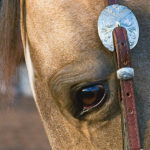When you bridle your horse, you need to maintain control while slipping the bit inside his mouth, pulling the crownpiece behind his ears, and securing the throatlatch.
 Credit: Julie Melocco When you bridle your horse, you need to maintain control while gently slipping the bit inside his mouth, pulling the crownpiece behind his ears, securing the throatlatch, and adjusting the chin strap. Here’s how. |
Credit: Julie Melocco When you bridle your horse, you need to maintain control while gently slipping the bit inside his mouth, pulling the crownpiece behind his ears, securing the throatlatch, and adjusting the chin strap. Here’s how. |It sounds straightforward, but if you bump your horse’s teeth with the bit, mishandle his sensitive ears, or make the wrong move, he can become head-shy and hard to bridle in the future.
Here, Certified Horsemanship Association international spokesperson Julie Goodnight shows you how to bridle your horse the right way. Here’s her seven-step method.
Step 1. Untie your horse. You don’t want him to pull back on the
lead rope in case he becomes startled while you’re bridling him.
Step 2. Reposition the halter. Unbuckle the halter, slip it off, then refasten it around your horse’s neck. This way, you can maintain control while leaving his head free for the bridle.
Step 3. Position the bridle. Hold the bridle in your left hand. Place your right wrist on your horse’s poll (between his ears), fingers pointing down. Transfer the bridle to your right hand, holding it by the crownpiece. This leaves your left hand free to place the bit in your horse’s mouth.
To learn how to bridle your horse the right way, watch this video from the Certified Horsemanship Association. CHA international spokesperson Julie Goodnight demonstrates.
https://www.youtube.com/watch?v=T7X5i4Tltkk
Step 4. Insert the bit. With your left hand, pull the chin strap back, out of the way. With all four fingers on the bit’s mouthpiece, gently bring the bit up to your horse’s mouth. Wait for him to open his mouth, then pull up on the headstall with your right hand to get the bit high in his mouth and prevent it from hitting his teeth.
Step 5. Secure the headstall. Gently fold your horse’s off-side (right) ear forward, and secure the headstall behind it. Then repeat with his near-side (left) ear. Square up the browband.
Step 6. Fasten the throatlatch. The throatlatch keeps the bridle in place and keeps it from accidentally coming off. Be sure that you can place three fingers, stacked one on top of the other, underneath the throatlatch. This adjustment holds the bridle in place without causing discomfort to your horse.
Step 7. Check the bit. Make sure the bit is level in your horse’s mouth.
Step 8. Adjust the chin strap. Make sure you can fit two fingers, stacked one on top of the other, between the strap and your horse’s jaw. Also make sure that when the bit’s shank reaches a 45 degree angle, the chin strap is engaged.
For more on CHA, visit http://www.CHA-ahse.org. Tofind a riding instructor or barn near you, visit http://www.CHAInstructors.com.
Julie Goodnight is a top horse trainer, clinician, and riding coach. She shares her easy-to-understand lessons on her weekly RFD-TV show, Horse Master, and through appearances at clinics and horse expos held throughout the United States. In 2008 she was named Equine Affaire’s Exceptional Equestrian Educator.
https://www.youtube.com/watch?v=T7X5i4Tltkk





